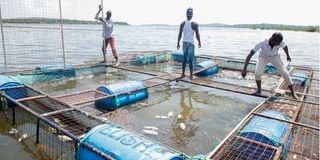Mass deaths: Fish farmers incur losses

Fishermen collect dead fish from fish cages in Lake Victoria on October 20, 2022.
Many farmers in Kisumu County are harvesting immature cage fish for sale at a throwaway price of Sh15 a piece to avoid losses due to increased deaths.
The lucky ones are storing the three to seven-month-old fish in cold chain facilities in the hope that prices may shoot up.
Tens of farmers who keep fish in cages have in the last several weeks suffered heavy losses as thousands of fish die due to what experts attribute to a natural phenomenon in the lake, coupled with the effects of global warming.
Mass fish deaths have been reported in Pier, Usoma, Genge and Dunga beaches.
Shelton Omollo, a cage fish farmer in Ogal beach, is among those affected.
Last Friday, Omollo woke up early to feed his fish, only to find them floating dead.
“We lost 25,000 four-month-old fish. I had prayed that we survive the calamity,” said Omollo.
The fisherman added that his Sh2.7 million investment had gone down the drain.
Farmers in Kisumu are the hardest hit though fish deaths have also been reported in Migori, Siaya, Homa Bay and Busia counties.
“Almost 50 tonnes of fish valued at Sh15 million has been harvested in Kisumu County alone and is being stored in private facilities to avoid losses,”
Dave Okech, the chairman of Cage Fish Farmers Association of Kenya, told Seeds of Gold.
Develop policies
Okech recently urged local insurance companies to develop policies and programmes that target cage farmers.
He also asked devolved governments to help set up cold rooms for fish farmers to increase the shelf-life of their yields.
Farmers and county and national government authorities had initially blamed the fish deaths on pollution of the lake.
However, Dr Christopher Aura, a researcher at Kenya Marine and Fisheries Research Institute (KMFRI), identified the cause as upwelling.
“This happens when the warm top water mixes with bottom cold water (usually with low oxygen) due to currents. It leads to suffocation of the wild and caged fish,” Dr Aura said.
For farmers engaging in cage aquaculture, the losses are higher since thousands of fish are in one place, he added.
Dr Aura said the oxygen levels are being depleted due to the ongoing decomposition of water hyacinth at the bottom of the lake.
“Decomposition of water plants is seasonal and is usually triggered by global warming. It happens without warning since this is dependent on increasing temperature and availability of debris like water hyacinth, algae or reeds,” he said.
According to Dr Aura and his team, ammonia gas produced by the decomposing plants has made the lake stink.
Fingerlings procured
Last week, Kisumu Governor Anyang Nyong’o procured fingerlings and feeds valued at Sh3 million to indemnify the affected cage fish farmers.
“We will buy another batch of fingerlings at Sh2 million and feeds of Sh1 million to be distributed to more farmers. This will help them restock and recover from the losses,” Prof Nyong’o said.
This is not the first time cage farmers have incurred losses blamed on upwelling.
In 2018, Siaya was the worst hit county as the others were spared the calamity.
Dr Aura also blamed the mass fish deaths on farmers installing cages in shallow waters.
Ideally, a farmer is expected to install a cage in areas with a minimum depth of 10 metres.
There is more oxygen in such depths and the flow of water helps to “self-clean”.
Mr Kobingi Nyakeya, another scientist at KMFRI, says Kenya might get better fish yields with proper cage management.
“If not controlled, the lake will face further degradation. Most of the feeds the local farmers are using have high nitrogen and phosphorus load, which increase the lake nutrient load,” Mr Nyakeya said, adding that the government needs to enforce feed standards.
He observes that only 10 per cent of the feeds that farmers use are safe for cage culture.
“The rest are low quality and have a tendency to sink, thus affecting the oxygen levels,” Mr Nyakeya added.
“In short, we are endangering the wild catch at the expense of the cage fish.”
There are 6,000 cages in Lake Victoria, with the majority being in Siaya County, according to KMFRI estimates.
The cage system was introduced in the Lake region years ago to boost fish production.
Some 3,180 tonnes of fish valued at Sh995.4 million were harvested from the cages in Lake Victoria in 2017.
This tonnage increased to 5,000 tonnes the following year.





